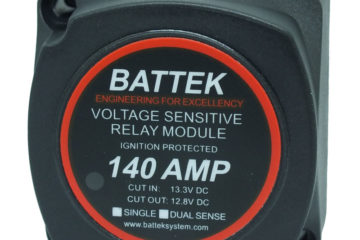Introduction
The most common usage for dual battery systems is that the two batteries are generally disconnected so that you can run loads from the auxilliary battery without discharging the starter battery and compromising the ability of your truck to start. However, you would also want the two batteries to reconnect when the truck is running so that you can charge the auxilliary battery (and the starter battery) from the truck’s alternator. Obviously the simplest solution is to have a manual isolator which connects or disconnect the two battery banks but with this you need to remember to connect the two when the truck is running, and disconnect them when you have stopped the engine.
Automatic Connection
If you want to automate this process, then you need single-pole single-throw (SPST) normally open (NO) relay/solenoid. Single pole in that it only acts on the live cable, single throw in that it either makes or breaks the circuit and does not change from one circuit to another, and normaly open, in that it the circuit is normally broken, unless the relay coil is energised and the circuit will be connected together. On any type of relay the coil can be designed to be activated in a number of ways. The most common application for a 12V SPST-NO relay is to have a 12V coil which is activated by a cable connected to your ignition. This means that when you turn the key in the ignition, the batteries are immediately connected.
Limitation
This system is normally fine, however there are certain circumstances under which it is possible to cause a few problems. The main problem arises when for some reason the starter battery is low on juice (left the headlights on) and the auxilliary battery has a good charge. In this situation when you turn the ignition one click the batteries are connected together, then when you try to turn the truck over the starter motor tries to pull all its power from the auxilliary battery because it will always take the path of least resistance. This is fine if the cabling to your second battery is adequate, the solenoid is rated for the full cranking current, and the battery is designed for starting, but in most installs this isn’t the case. For example for a truck that have a leisure battery which is great for deep cycling but inadequate to provide cranking amps, the cable is completely undersized to power a starter motor, and the disconnect solenoid is only rated at 60A continuous.
Voltage Sensitive Relay Method
For such situation, an alternative way of triggering the solenoid to connect the batteries after the truck has started is needed. The most common way of doing this is using what is called a voltage sensitive relay. Basically the coil in the relay doesn’t activate and connect your two batteries together unless a certain voltage is reached. This voltage is preset at 13.3V to be higher than a battery that is well charged, but lower than the typical voltage output of an alternator. Therefore the solenoid wont activate untill the engine is running and the alternator is operating. As soon as the engine is stopped and the voltage drops back to lower than 12.8V or that of a well charged battery, the VSR disconnects the two batteries again.
VSR is certainly the simplest and most robust automated connect/disconnect system.



0 Comments